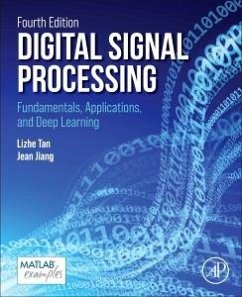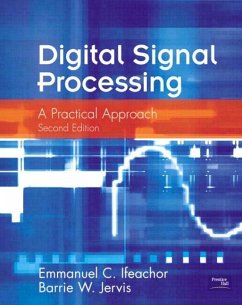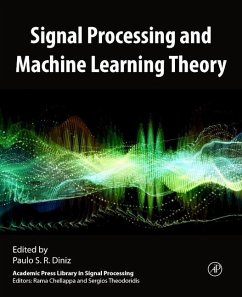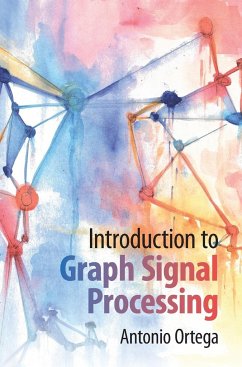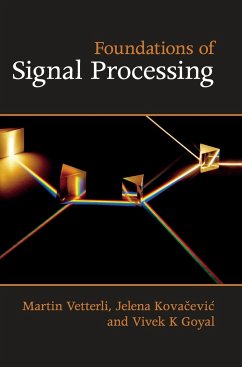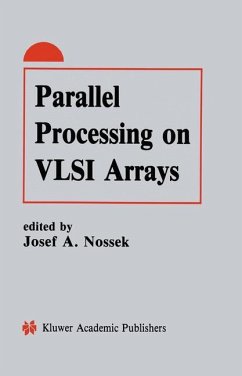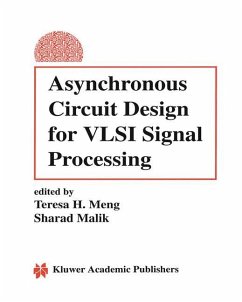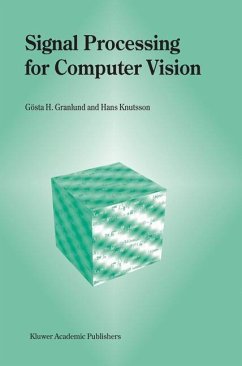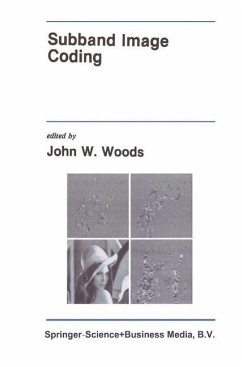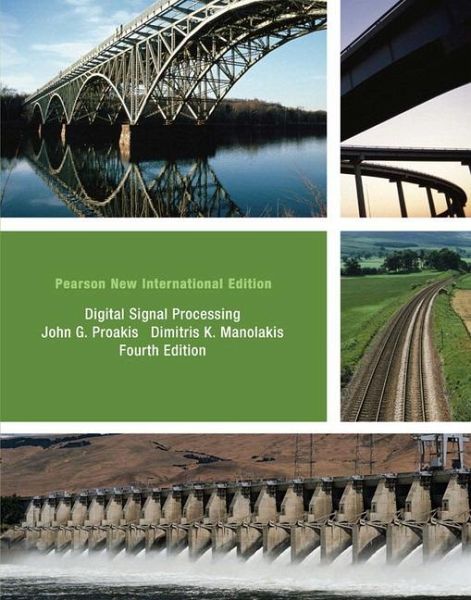
Digital Signal Processing
Pearson New International Edition

PAYBACK Punkte
62 °P sammeln!
A significant revision of a best-selling text for the introductory digital signal processing course.
This book presents the fundamentals of discrete-time signals, systems, and modern digital processing and applications for students in electrical engineering, computer engineering, and computer science.The book is suitable for either a one-semester or a two-semester undergraduate level course in discrete systems and digital signal processing. It is also intended for use in a one-semester first-year graduate-level course in digital signal processing.
Features + Benefits
NEW - added a new chapter on adaptive filters
NEW - substantially modified and updated the chapter on multirate digital signal processing
NEW - substantially modified and updated the chapter on sampling and reconstruction of signals
NEW - new material added on the Discrete Cosine Transform.
* A balanced coverage is provided of both theory and practical applications.
* Includes many examples throughout the book and approximately 500 homework problems.
* Describes the operations and techniques involved in the analog-to-digital conversion of analog signals.
* Studies the characterization and analysis of linear time-invariant discrete-time systems and discrete- time signals in the time domain.
* Considers both the bilateral and the unilateral z-transform, and describes methods for determining the inverse z-transform.
* Analyzes signals and systems in the frequency domain, and presents Fourier series and Fourier transform in both continuous-time and discrete-time signals.
* Treats the realization of IIR and FIR systems, including direct-form, cascade, parallel, lattice and lattice-ladder realizations.
* Looks at the basics of sampling rate conversion and presents systems for implementing multirate conversion.
* Offers a detailed examination of power spectrum estimation, with discussions on nonparametric and model-based methods, as well as eigen-decomposition- based methods, including MUSIC and ESPRIT.
1 Introduction
1.1 Signals, Systems, and Signal Processing
1.2 Classification of Signals
1.3 The Concept of Frequency in Continuous-Time and Discrete-Time Signals
1.4 Analog-to-Digital and Digital-to-Analog Conversion
1.5 Summary and References
2 Discrete-Time Signals And Systems
2.1 Discrete-Time Signals
2.2 Discrete-Time Systems
2.3 Analysis of Discrete-Time Linear Time-Invariant systems
2.4 Discrete-Time Systems Described by Difference Equations
2.5 Implementation of Discrete-Time Systems
2.6 Correlation of Discrete-Time Signals
2.7 Summary and References
3 The Z-Transform And Its Application To The Analysis Of Lti Systems
3.1 The z-Transform
3.2 Properties of the z-Transform
3.3 Rational z-Transforms
3.4 Inversion of the z-Transform
3.5 Analysis of Linear Time Invariant Systems in the z-Domain
3.6 The One-sided z-Transform
3.7 Summary and References
4 Frequency Analysis Of Signals And Systems
4.1 Frequency Analysis of Continuous-Time Signals
4.2 Frequency Analysis of Discrete-Time Signals
4.3 Frequency-Domain and Time-Domain Signal Properties
4.4 Properties of the Fourier Transform for Discrete-Time Signals
4.5 Summary and References
5 Frequency Domain Analysis Of Lti Systems
5.1 Frequency-Domain Characteristics of Linear Time-Invariant Systems
5.2 Frequency Response of LTI Systems
5.3 Correlation Functions and Spectra at the Output of LTI Systems
5.4 Linear Time-Invariant Systems as Frequency-Selective Filters
5.5 Inverse Systems and Deconvolution
5.6 Summary and References
6 Sampling And Reconstruction Of Signals
6.1 Ideal Sampling and Reconstruction of Continuous-Time Signals
6.2 Discrete-Time Processing of Continuous-Time Signals
6.3 Analog-to-Digital and Digital-to-Analog Converters
6.4 Sampling and Reconstruction of Continuous-Time Bandpass Signals
6.5 Sampling of Discrete-Time Signals
6.6 Oversampling A/D and D/A Converters
6.7 Summary and References
7 The Discrete Fourier Transform: Its Properties And Applications
7.1 Frequency Domain Sampling:The Discrete Fourier Transform
7.2 Properties of the DFT
7.3 Linear Filtering Methods Based on the DFT
7.4 Frequency Analysis of Signals Using the DFT
7.5 The Discrete Cosine Transform
7.6 Summary and References
8 Efficient Computaiton Of The Dft: Fast Fourier Transform Algorithms
8.1 Efficient Computation of the DFT: FFT Algorithms
8.2 Applications of FFT Algorithms
8.3 A Linear Filtering Approach to Computation of the DFT
8.4 Quantization Effects in the Computation of the DFT
8.5 Summary and References
9 Implementation Of Discrete-Time Systems
9.1 Structures for the Realization of Discrete-Time Systems
9.2 Structures for FIR Systems
9.3 Structures for IIR Systems
9.4 Representation of Numbers
9.5 Quantization of Filter Coefficients
9.6 Round-Off Effects in Digital Filters
9.7 Summary and References
10 Design Of Digital Filers
10.1 General Considerations
10.2 Design of FIR Filters
10.3 Design of IIR Filters From Analog Filters
10.4 Frequency Transformations
10.5 Summary and References
11 Multirate Digital Signal Processing
11.1 Introduction
11.2 Decimation by a Factor D
11.3 Interpolation by a Factor I
11.4 Sampling Rate Conversion by a Rational Factor I/D
11.5 Implementation of Sampling Rate Conversion
11.6 Multistage Implementation of Sampling Rate Conversion
11.7 Sampling Rate Conversion of Bandpass Signals
11.8 Sampling Rate conversion by an Arbitrary Factor
11.9 Applications of Sampling Rate Conversion
11.10 Digital Filter Banks
11.11 Two-Channel Quadrature Mirror Filter Bank
11.12 M-Channel QMF Bank
11.13 Summary and References
12 Linear Prediction And Optimum Linear Filters
12.1 Random Signals, Correlation Functions and Power Spectra
12.2 Innovations Representation of a Stationary Random Process
12.3 Forward and Backward Linear Prediction
12.4 Solution of the Normal Equations
12.5 Properties of the Linear Prediction-Error Filters
12.6 AR Lattice and ARMA Lattice-Ladder Filters
12.7 Wiener Filters for Filtering and Prediction
12.8 Summary and References
13 Adaptive Filters
13.1 Applications of Adaptive Filters
13.2 Adaptive Direct-Form FIR Filters-The LMS Algorithm
13.3 Adaptive Direct-Form FIR Filters-RLS Algorithms
13.4 Adaptive Lattice-Ladder Filters
13.5 Summary and References
Appendices
Appendix A Random Number Generators
Appendix B Tables of Transition Coefficients for the Design of Linear-Phase Filters
References and Bibliography
Index
This book presents the fundamentals of discrete-time signals, systems, and modern digital processing and applications for students in electrical engineering, computer engineering, and computer science.The book is suitable for either a one-semester or a two-semester undergraduate level course in discrete systems and digital signal processing. It is also intended for use in a one-semester first-year graduate-level course in digital signal processing.
Features + Benefits
NEW - added a new chapter on adaptive filters
NEW - substantially modified and updated the chapter on multirate digital signal processing
NEW - substantially modified and updated the chapter on sampling and reconstruction of signals
NEW - new material added on the Discrete Cosine Transform.
* A balanced coverage is provided of both theory and practical applications.
* Includes many examples throughout the book and approximately 500 homework problems.
* Describes the operations and techniques involved in the analog-to-digital conversion of analog signals.
* Studies the characterization and analysis of linear time-invariant discrete-time systems and discrete- time signals in the time domain.
* Considers both the bilateral and the unilateral z-transform, and describes methods for determining the inverse z-transform.
* Analyzes signals and systems in the frequency domain, and presents Fourier series and Fourier transform in both continuous-time and discrete-time signals.
* Treats the realization of IIR and FIR systems, including direct-form, cascade, parallel, lattice and lattice-ladder realizations.
* Looks at the basics of sampling rate conversion and presents systems for implementing multirate conversion.
* Offers a detailed examination of power spectrum estimation, with discussions on nonparametric and model-based methods, as well as eigen-decomposition- based methods, including MUSIC and ESPRIT.
1 Introduction
1.1 Signals, Systems, and Signal Processing
1.2 Classification of Signals
1.3 The Concept of Frequency in Continuous-Time and Discrete-Time Signals
1.4 Analog-to-Digital and Digital-to-Analog Conversion
1.5 Summary and References
2 Discrete-Time Signals And Systems
2.1 Discrete-Time Signals
2.2 Discrete-Time Systems
2.3 Analysis of Discrete-Time Linear Time-Invariant systems
2.4 Discrete-Time Systems Described by Difference Equations
2.5 Implementation of Discrete-Time Systems
2.6 Correlation of Discrete-Time Signals
2.7 Summary and References
3 The Z-Transform And Its Application To The Analysis Of Lti Systems
3.1 The z-Transform
3.2 Properties of the z-Transform
3.3 Rational z-Transforms
3.4 Inversion of the z-Transform
3.5 Analysis of Linear Time Invariant Systems in the z-Domain
3.6 The One-sided z-Transform
3.7 Summary and References
4 Frequency Analysis Of Signals And Systems
4.1 Frequency Analysis of Continuous-Time Signals
4.2 Frequency Analysis of Discrete-Time Signals
4.3 Frequency-Domain and Time-Domain Signal Properties
4.4 Properties of the Fourier Transform for Discrete-Time Signals
4.5 Summary and References
5 Frequency Domain Analysis Of Lti Systems
5.1 Frequency-Domain Characteristics of Linear Time-Invariant Systems
5.2 Frequency Response of LTI Systems
5.3 Correlation Functions and Spectra at the Output of LTI Systems
5.4 Linear Time-Invariant Systems as Frequency-Selective Filters
5.5 Inverse Systems and Deconvolution
5.6 Summary and References
6 Sampling And Reconstruction Of Signals
6.1 Ideal Sampling and Reconstruction of Continuous-Time Signals
6.2 Discrete-Time Processing of Continuous-Time Signals
6.3 Analog-to-Digital and Digital-to-Analog Converters
6.4 Sampling and Reconstruction of Continuous-Time Bandpass Signals
6.5 Sampling of Discrete-Time Signals
6.6 Oversampling A/D and D/A Converters
6.7 Summary and References
7 The Discrete Fourier Transform: Its Properties And Applications
7.1 Frequency Domain Sampling:The Discrete Fourier Transform
7.2 Properties of the DFT
7.3 Linear Filtering Methods Based on the DFT
7.4 Frequency Analysis of Signals Using the DFT
7.5 The Discrete Cosine Transform
7.6 Summary and References
8 Efficient Computaiton Of The Dft: Fast Fourier Transform Algorithms
8.1 Efficient Computation of the DFT: FFT Algorithms
8.2 Applications of FFT Algorithms
8.3 A Linear Filtering Approach to Computation of the DFT
8.4 Quantization Effects in the Computation of the DFT
8.5 Summary and References
9 Implementation Of Discrete-Time Systems
9.1 Structures for the Realization of Discrete-Time Systems
9.2 Structures for FIR Systems
9.3 Structures for IIR Systems
9.4 Representation of Numbers
9.5 Quantization of Filter Coefficients
9.6 Round-Off Effects in Digital Filters
9.7 Summary and References
10 Design Of Digital Filers
10.1 General Considerations
10.2 Design of FIR Filters
10.3 Design of IIR Filters From Analog Filters
10.4 Frequency Transformations
10.5 Summary and References
11 Multirate Digital Signal Processing
11.1 Introduction
11.2 Decimation by a Factor D
11.3 Interpolation by a Factor I
11.4 Sampling Rate Conversion by a Rational Factor I/D
11.5 Implementation of Sampling Rate Conversion
11.6 Multistage Implementation of Sampling Rate Conversion
11.7 Sampling Rate Conversion of Bandpass Signals
11.8 Sampling Rate conversion by an Arbitrary Factor
11.9 Applications of Sampling Rate Conversion
11.10 Digital Filter Banks
11.11 Two-Channel Quadrature Mirror Filter Bank
11.12 M-Channel QMF Bank
11.13 Summary and References
12 Linear Prediction And Optimum Linear Filters
12.1 Random Signals, Correlation Functions and Power Spectra
12.2 Innovations Representation of a Stationary Random Process
12.3 Forward and Backward Linear Prediction
12.4 Solution of the Normal Equations
12.5 Properties of the Linear Prediction-Error Filters
12.6 AR Lattice and ARMA Lattice-Ladder Filters
12.7 Wiener Filters for Filtering and Prediction
12.8 Summary and References
13 Adaptive Filters
13.1 Applications of Adaptive Filters
13.2 Adaptive Direct-Form FIR Filters-The LMS Algorithm
13.3 Adaptive Direct-Form FIR Filters-RLS Algorithms
13.4 Adaptive Lattice-Ladder Filters
13.5 Summary and References
Appendices
Appendix A Random Number Generators
Appendix B Tables of Transition Coefficients for the Design of Linear-Phase Filters
References and Bibliography
Index
A significant revision of a best-selling text for the introductory digital signal processing course. This book presents the fundamentals of discrete-time signals, systems, and modern digital processing and applications for students in electrical engineering, computer engineering, and computer science.The book is suitable for either a one-semester or a two-semester undergraduate level course in discrete systems and digital signal processing. It is also intended for use in a one-semester first-year graduate-level course in digital signal processing.
Dieser Artikel kann nur an eine deutsche Lieferadresse ausgeliefert werden.




